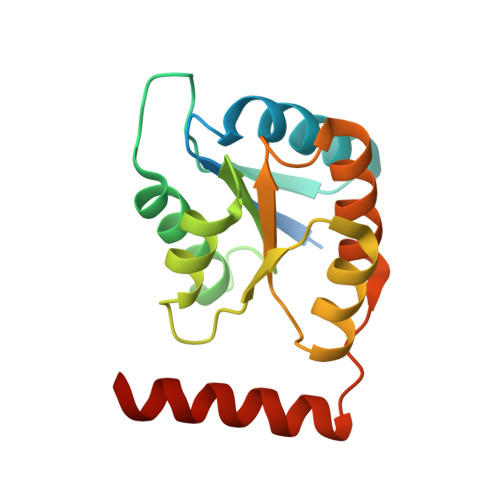Crystal structure of Clostridium thermocellum ribose-5-phosphate isomerase B reveals properties critical for fast enzyme kinetics.
Jung, J., Kim, J.K., Yeom, S.J., Ahn, Y.J., Oh, D.K., Kang, L.W.(2011) Appl Microbiol Biotechnol 90: 517-527
- PubMed: 21253719
- DOI: https://doi.org/10.1007/s00253-011-3095-8
- Primary Citation of Related Structures:
3HE8, 3HEE, 3PH3, 3PH4 - PubMed Abstract:
Ribose-5-phosphate isomerase (Rpi) catalyzes the conversion of D-ribose 5-phosphate (R5P) to D-ribulose 5-phosphate, which is an important step in the non-oxidative pathway of the pentose phosphate pathway and the Calvin cycle of photosynthesis. Recently, Rpis have been used to produce valuable rare sugars for industrial purposes. Of the Rpis, D-ribose-5-phosphate isomerase B from Clostridium thermocellum (CtRpi) has the fastest reactions kinetics. While Thermotoga maritime Rpi (TmRpi) has the same substrate specificity as CtRpi, the overall activity of CtRpi is approximately 200-fold higher than that of TmRpi. To understand the structural basis of these kinetic differences, we determined the crystal structures, at 2.1-Å resolution or higher, of CtRpi alone and bound to its substrates, R5P, D-ribose, and D-allose. Structural comparisons of CtRpi and TmRpi showed overall conservation of their structures with two notable differences. First, the volume of the CtRpi substrate binding pocket (SBP) was 20% less than that of the TmRpi SBP. Second, the residues next to the sugar-ring opening catalytic residue (His98) were different. We switched the key residues, involved in SBP shaping or catalysis, between CtRpi and TmRpi by site-directed mutagenesis, and studied the enzyme kinetics of the mutants. We found that tight interactions between the two monomers, narrow SBP width, and the residues near the catalytic residue are all critical for the fast enzyme kinetics of CtRpi.
Organizational Affiliation:
Department of Advanced Technology Fusion, Konkuk University, Hwayang dong, Gwangjin-gu, Seoul 143-701, South Korea.















